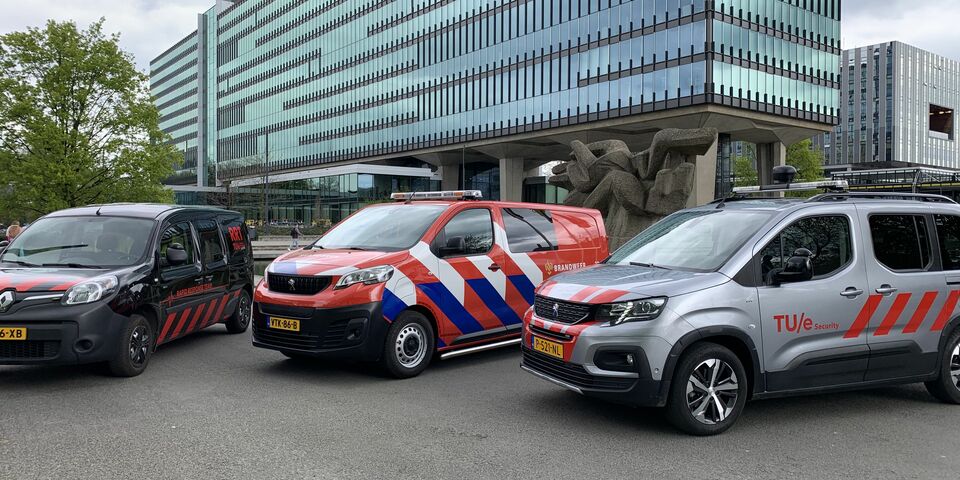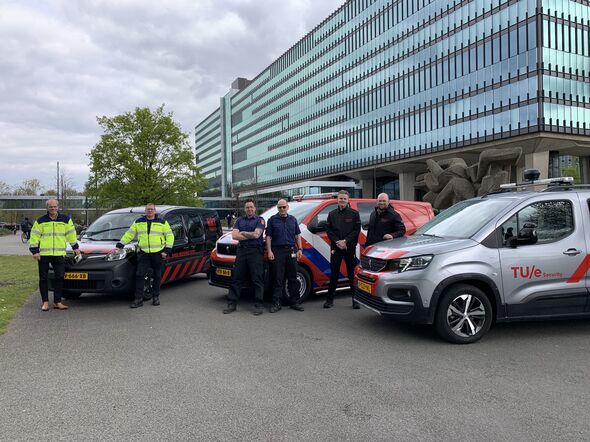Fire service, security and RRT go electric
TU/e's fire service, security service and rapid response team have recently gained a new fleet of vehicles and have made the switch to electric. TU/e's security service was the first to make the switch, back in 2014. You may have seen the RRT car parked on the campus. It is often stationed near a building rather than in a car park. But why do we have this service and what does it do?
You may have seen the RRT car parked outside a building, but what exactly does it have in the way of equipment and what added value does an RRT team bring? Firefighter Tim Schippers: “The RRT car carries an extensive first aid kit, but alongside this it has other resources, like a bag containing a chemical burns rinsing kit, which is part of an extensive kit geared to the risks specific to this campus. It also carries an AED and a stop-the-bleed kit. It should be said that all the equipment carried in the RRT car is duplicated in the security car. Security has to be identically equipped because, in principle, after 16.30 hrs they take over the tasks of the RRT.”
TU/e has its own fire service, security and BHV volunteers (first responders), so what's the added value of the RRT car? Schippers: “The RRT is staffed by fire service employees and some BHV volunteers with a focus on those buildings that don't have their own BHV volunteers, like Neuron or Gaslab, as well as buildings whose BHV team (Emergency Response Team) is understaffed; these tend to be the smaller buildings with far fewer users. But the RRT might also want to go to a larger building and seek help. The car enables them to get across the campus quickly in the event of an incident; they'll always arrive within five minutes.”
The university's first response system was successfully updated in July 2021. The RRT is the fruit of a pilot carried out as part of that process. Fire service chief Eric van der Heijden: “We took stock in 2019: ‘How are we doing things now and how could they be done better, bearing in mind the changes expected on campus in the future?’ We were looking for a solution, in particular for the growing number of buildings without their own BHV team, and in the RR we found what we needed.”
Electric call-outs
So, the regular vehicles of the fire service, security and RRT have been replaced with more sustainable electric versions, “but not the call-out vehicle”, observes Van der Heijden. “Development in that area is less advanced: I know of only one electric call-out vehicle. It's in Amsterdam. But we are certainly open to the idea of using one here.”
But switching to an electric call-out vehicle wouldn't mean the team could ditch diesel fuel: the extinguishing equipment runs off a diesel generator, even in the electric vehicles. “Yup, that's a shame, for sure,” says Schippers. “But there are plenty of smart, technically-minded people at TU/e, maybe they could come up with a solution. And, you know, it would work for us on campus if we could plug in somewhere near a building and start firefighting. A call-out vehicle is really nothing more than a truck with a pump and firefighting equipment.” Even so, an electric firefighting truck, fully kitted out, carries a hefty price tag: 1.2 million euros. And that's without electric firefighting capacity.
Increased range
The fire service's vehicles are charged on fire service premises, the one belonging to security at a charging point near their base. But given the many trips they make, they have to charge up every hour. How often are the teams called out? Van der Heijden: “Three times a week on average.” Security colleague Joop Antonissen: “But it could be three times a day, or not at all in a week. It's really variable here.”
“Over the years the range has really improved,” says team leader security Hay Becks. “Our first electric vehicle, purchased in 2014, could really only go 70 kilometers before needing to be recharged, mainly because of all the short trips involved in surveillance work. The range was even less in winter when we needed the heating on.”
Becks’s colleague Antonissen, one of whose tasks is car maintenance, agrees: “Yes, the car we have now can do about 220 kilometers on the job, but its heating system still consumes a fair amount of power in winter.” The car purchased by the security team in 2019 has now been passed on to the RRT. “That car started out covering about 600 kilometers a week, and now it's doing about thirty. So we've found the perfect new use for it.”



Discussion